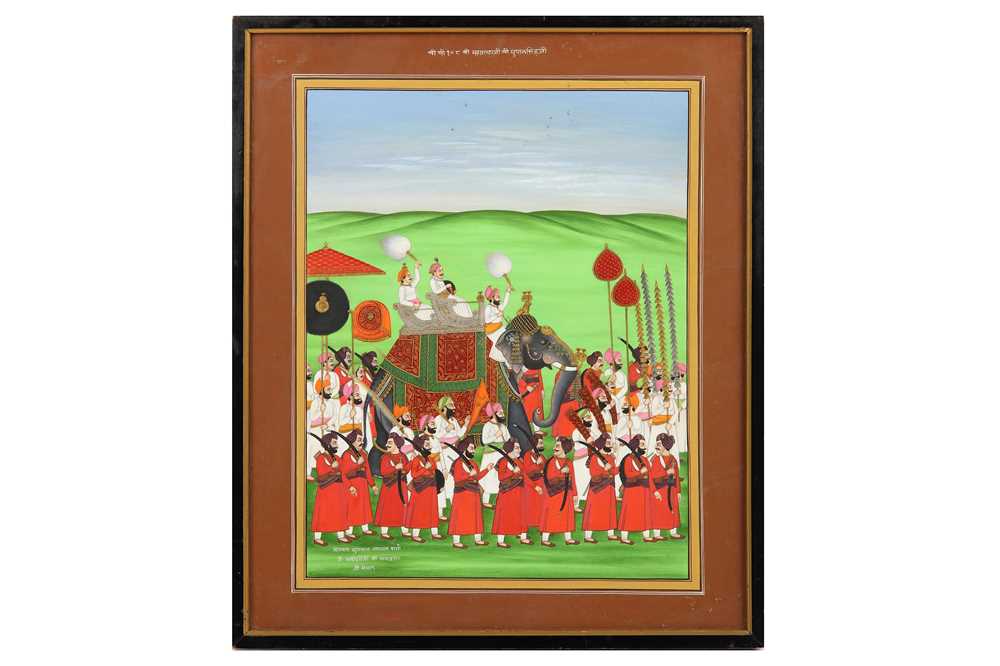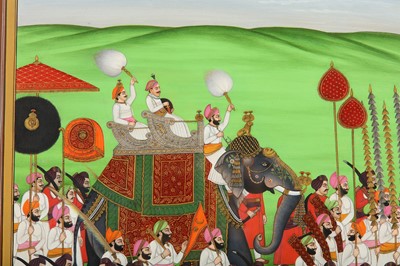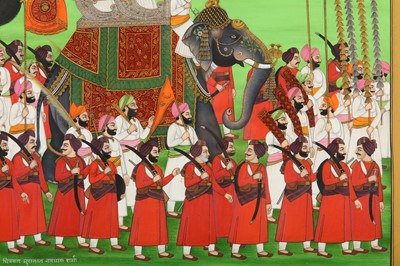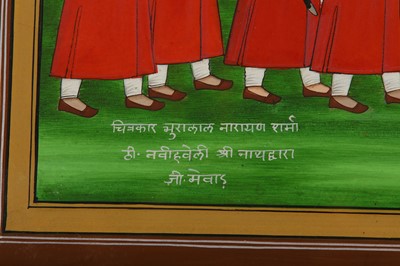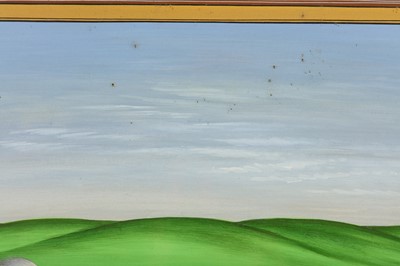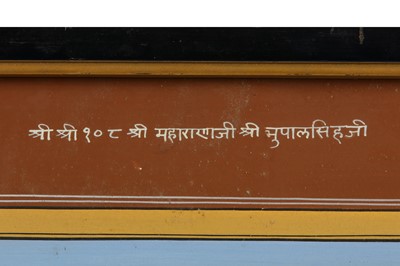22nd Jul, 2020 15:00
Islamic & Indian Art
THE PROCESSION OF MAHARANA BHUPAL SINGH (1884 - 1955) TO NATHDWARA
Mewar, Rajasthan, North-Western India, circa 1930s - 40s, signed by the painter Bhuralaal Narayan Sharma
THE PROCESSION OF MAHARANA BHUPAL SINGH (1884 - 1955) TO NATHDWARA
Mewar, Rajasthan, North-Western India, circa 1930s - 40s, signed by the painter Bhuralaal Narayan Sharma
Opaque pigments heightened with gold and silver on paper, the vertical composition depicting the ruler of Udaipur (Mewar), Maharana Bhupal Singh, in full regalia in the centre of a procession, seated in a howdah on an elegantly clad and heavily bejewelled elephant, a white-clad mahout and attendant seated at the front and back, both holding large fly whisks, the mace and flag bearers following the crowd on the side of the royal elephant, in the front of the procession white-clad attendants and servants with tall drop-shaped standards; rolled embroidered textiles; and gold and silver poles, in the back further attendants with shields and parasols, in the foreground a line of red-dressed, armed foot soldiers escorting the procession, the scene set against a hilly green ground, within caramel and brown borders in black and white rules, signed in white Devanagari script in the lower left corner 'Chitrakaar Bhuralaal Narayan Sharma, thhi. Navi Haveli Shri Nathdwaaraa zii. Mewar' and with an inscription on the top 'Shri Shri 20 (?) Shri Maharanaji Shri Bhupal Singh Ji', mounted, glazed and framed, with an old framers' label The Parker Gallery, 2 Albermarle Street, London W1, 44.5cm x 37.5cm including the frame.
An almost identical procession painting with Maharana Bhupal Singh as main subject was successfully sold at Christie's King Street, 10 June 2015, lot 89. Shri Maharana Bhupal Singh was the ruler of the princely state of Udaipur (Mewar) from 1930 and Rajapramukh of Rajasthan from 1948 until his death on 4th July 1955. He suffered from spine injury and paralysis since the age of 5, and he's often depicted with a smaller torso and bent back. Nonetheless he managed to seize the throne and guide Mewar and Rajasthan through modern India’s tumultuous era with a deep sense of patriotism and courage.
The inscription on the lower left corner suggests this painting being probably commissioned to commemorate the Maharana's procession to the city of Nathdwara, in the province of Mewar. This city is a key religious site for the worship of Sri Nath Ji, the child-like form of the Hindu deity Krishna. The temple is also popularly called Shrinathji ki Haveli (House of Shrinathji) and it is believed to have been built on this site in the 17th century during the reign of the Mughal Emperor Aurangzeb, to prevent the destruction of the Sri Nath Ji murti during the Hindu iconoclastic fury of the time.
Dimensions: 44.5cm x 37.5cm including the frame
Sold for £875
Includes Buyer's Premium
Do you have an item similar to the item above? If so please click the link below to request a free online valuation through our website.
